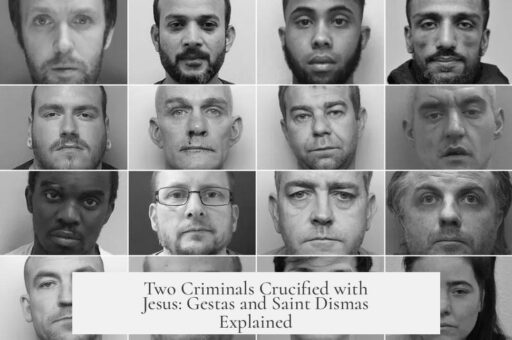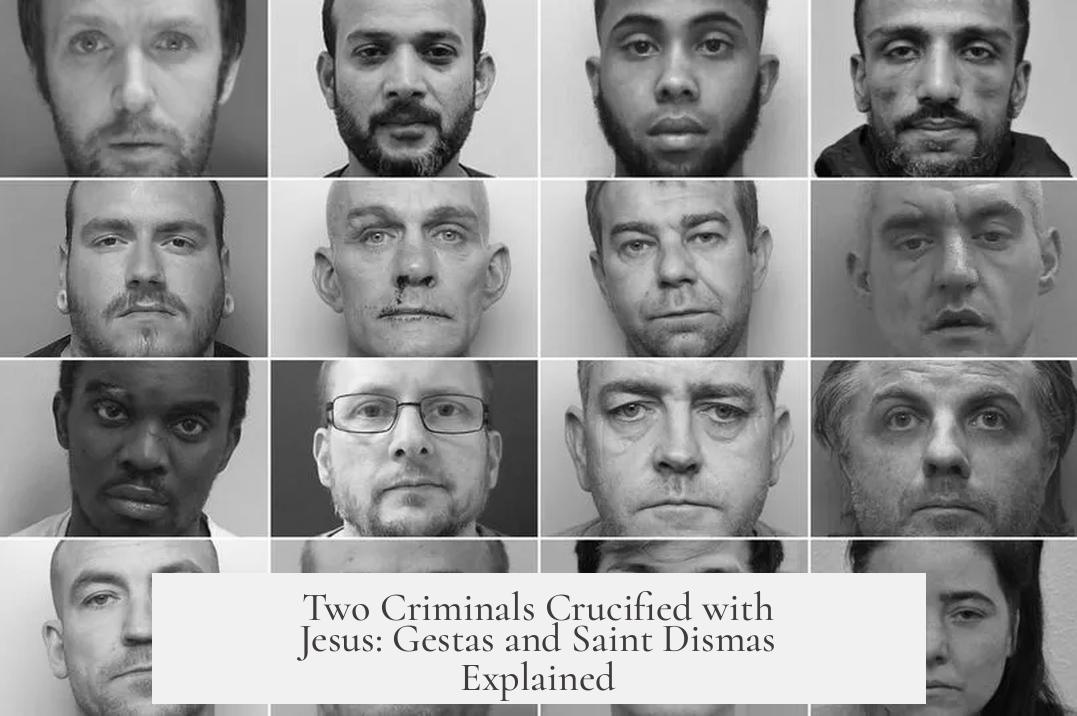The two criminals crucified together with Jesus Christ are not named or clearly identified in the canonical Gospels. However, Christian tradition and apocryphal writings name them as Gestas, who mocked Jesus, and Saint Dismas, who sought forgiveness and was promised Paradise by Jesus.

The Gospels offer differing accounts of the two men crucified alongside Jesus. The Gospel of John largely omits any mention of them and provides no details about their involvement or identities. In contrast, the Synoptic Gospels—Matthew, Mark, and especially Luke—describe their presence and interaction, but they remain unnamed.
Luke’s Gospel provides the most distinctive characterization. One criminal mocks Jesus, challenging Him amidst their shared punishment. The other rebukes the first and asks Jesus to remember him when He enters His kingdom. Jesus replies, “Amen, I say to you, today you will be with me in Paradise” (Luke 23:43). This exchange highlights the penitent criminal’s faith and Jesus’ promise of salvation.

Following the canonical texts, later Christian tradition assigns names to the two criminals, drawing mostly from apocryphal writings and folk beliefs developed within early Christianity. Gestas is traditionally identified as the thief who mocked Jesus, while Saint Dismas is the penitent thief who sought mercy. These names do not appear in the Bible but emerge in Western and Latin Church traditions.
Theological reflection and cultural storytelling further expanded their identities. Early Church Fathers such as St. Augustine, St. John Chrysostom, and St. Gregory the Great wrote about the thieves’ possible backgrounds and significance. Their interpretations emphasize moral lessons on repentance and forgiveness, aligning with the contrasting attitudes exhibited by the two criminals at the crucifixion.

| Aspect | Details | Source/Reference |
|---|---|---|
| Gospel Identification | No names given; roles vary across accounts. John excludes them largely; Luke depicts one mocking and the other penitential. | Luke 23:39-43; Gospel narratives |
| Church Tradition Names | Gestas identified as the mocking thief; Saint Dismas as the penitent thief who receives Jesus’ promise of Paradise. | Western/Latin Christendom traditions; Apocryphal writings |
| Jesus’ Promise | “Amen, I say to you today you will be with me in Paradise.” | Luke 23:43 |
| Theological Elaboration | Early Church Fathers elaborated on their stories to teach repentance and salvation. | Writings of Augustine, Chrysostom, Gregory the Great |
The two criminals’ story reflects divergent human responses to suffering and judgment. One mocks and denies Jesus’ identity, the other demonstrates faith and repentance. This contrast highlights the theme of salvation available even at the last moment.
The lack of direct naming in the Gospels suggests the focus remains on Jesus rather than his companions in crucifixion. Yet, over centuries, tradition has filled in gaps to provide concrete identities and deepen the moral narrative surrounding the crucifixion scene.

While the canonical texts keep the criminals unnamed and mostly anonymous, their symbolic role is prominent in Christian teaching:
- They represent humanity’s choice between rejection and acceptance of Jesus’ message.
- The penitent thief exemplifies faith leading to redemption, even at death’s door.
- The mocking thief illustrates the consequences of unbelief and scorn.
These roles have shaped Christian art, liturgy, and sermons throughout history.

Key takeaways:
- The Gospels do not name the two criminals crucified with Jesus.
- Luke uniquely records one criminal’s repentance and Jesus’ promise of Paradise.
- Church tradition names them Gestas (the mocker) and Saint Dismas (the penitent).
- Early Church Fathers elaborated their stories for theological reflection.
- Their contrasting responses illustrate human choice regarding faith and salvation.
Who Were the Two Criminals Crucified Together with Jesus Christ?

The two criminals crucified alongside Jesus are traditionally known as Gestas and Saint Dismas, though the Bible itself never names them. This little-known yet intriguing detail sparks curiosity whenever people dive into the Gospel accounts or hear the Christmas story retold. But who exactly were these men? What roles did they play? And how much of what we “know” comes from scripture, church tradition, or a dash of storytelling flair? Let’s unravel this ancient mystery.
The Gospel Accounts: A Mysterious Pair

If you crack open the Bible and head straight to the crucifixion scene, you’ll find the two men there, but their identities remain a blank canvas. The four Gospels—Matthew, Mark, Luke, and John—mention these two men differently, or sometimes not at all.
- The Gospel of John mostly sidesteps them. In this account, they’re barely present, almost forgotten side characters.
- In the other three Gospels, particularly in Luke, the two criminals gain personality traits:
- One criminal mocks Jesus, joining the chorus of jeers from the crowd.
- The other, in an awe-inspiring act of humility, asks Jesus for mercy.
Luke captures this touching exchange where the penitent man asks Jesus to remember him when He comes into His kingdom. Jesus responds with the now-famous promise:
“Amen, I say to you today you will be with me in Paradise.” (Luke 23:43)
This is a rare moment of grace amid agony—a testament to forgiveness and hope.
Who Are Gestas and Saint Dismas? Enter Church Tradition
So, if the Bible is silent on their names, where do “Gestas” and “Saint Dismas” come from? Let’s thank the Church Fathers and apocryphal writings, those texts that didn’t make the biblical cut but influenced early Christian teaching and folklore.
According to Western Christian tradition:
- Gestas is the “bad thief,” the one who mocks Jesus.
- Saint Dismas is the “good thief,” the penitent, who receives Jesus’ mercy.
This characterization paints a vivid contrast between rejection and acceptance of Christ, symbolizing the spiritual crossroads faced by humanity.
Interestingly, while these names appear in many folk traditions and are widely recognized in Western Christianity, they are not found in official Church doctrine or the New Testament. Instead, they emerge from beloved but non-canonical apocryphal texts and theological reflections.
Theological Reflections from Early Church Thinkers
Over the centuries, prominent theologians elaborated on these two men’s stories, weaving lessons and symbolism into their lives. Writers like St. Augustine, St. John Chrysostom, and St. Gregory the Great contemplated their possible backgrounds, sins, and repentance. However, all these reflections remain speculative, based on piety rather than scripture.
Such developments show how early Christianity sought to deepen the meaning of every disciple’s journey, even those at society’s fringes, like the two crucified criminals. Their stories remind believers that redemption remains accessible till the last breath.
Why Does This Matter Today?
Beyond curiosity, these two criminals remind us of powerful spiritual lessons:
- Choice in the Face of Judgment: Gestas and Dismas exemplify divergent responses to suffering and justice.
- Hope in Despair: Dismas’ faith in Jesus’ mercy offers hope even in dire final moments.
- Humanizing the Marginalized: Their presence shows that Jesus’ message isn’t just for the religious elite but touches all lives, including sinners and outcasts.
So next time you hear about the crucifixion, pause and consider these two lesser-known figures. They add depth, drama, and human complexity to a pivotal event.
Fun Fact: How Did Their Stories Spread?
The names Gestas and Dismas appear mainly through the Golden Legend, a medieval collection of saint stories, and in popular artworks, church plays, and literature. They’re part of the fabric of Christian culture, even if they don’t appear in your Bible’s footnotes.
Imagine these thieves as the world’s oldest “dynamic duo,” lending extra colors—shades of good and bad—to the greatest story ever told.
In Summary:
| Aspect | Details | Source/Reference |
|---|---|---|
| Gospel Identification | Two unnamed criminals; John barely mentions them; Luke depicts one mocking and one penitent | Luke 23:43 and other Gospels |
| Church Tradition Names | Gestas (mocking thief) and Saint Dismas (penitent thief) | Western Christian tradition and apocryphal writings |
| Jesus’ Promise | “Amen, I say to you today you will be with me in Paradise” | Luke 23:43 |
| Theological Expansions | Early Church Fathers speculated on their background and repentance | Writings of Augustine, Chrysostom, Gregory the Great |
Final Thoughts
Apparently, the two criminals crucified with Jesus do more than act as fringe characters; they highlight themes of judgment, mercy, and transformation. Their stories invite us to reflect on forgiveness and redemption—not just ancient history but timeless spiritual realities. And who knows? Maybe next time you’re in a theological trivia contest, you’ll ace the question: “Who were Gestas and Dismas?”
So, what do you think? Can the story of two nameless men teach us something about the power of mercy in our own lives?



